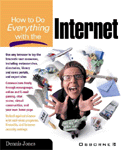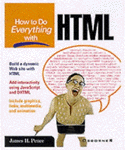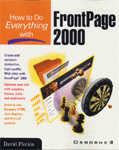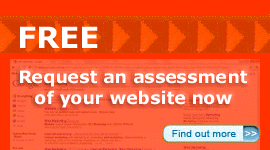How to do Everything series, the Internet, HTML, Frontpage and Yahoo!
The Internet

Published by Osborne/McGraw-Hill, 2001
Paperback, 426 pages
ISBN: 0-07-213028-8
This series of titles from Osborne help to guide readers through the subject in question with well laid out, easy-to-read chapters, interspersed with 'How to' and 'Did you know?' panels, notes, tips and cautions related to the subject of discussion. The books are aimed at users with some basic knowledge but who want to get more from the subject.
The title covering the Internet could potentially encompass many aspects of this communications medium, but is divided into 5 sections that cover the 'essential basics'. The first section starts with using browsers and connecting to the Internet. The next section deals with the uses of the web, involving saving documents and images, downloading and installing software, using FTP and multimedia.
The third section of the book covers communication aspects of the Internet, with e-mail, newsgroups, chat rooms, online gaming and trade. With the importance of security also being a big issue, section four discusses issues of privacy, safety and viruses, leaving the final section to cover setting up a website.
In some ways, there is too much to cover here and you can come away feeling that the introduction to some issues, such as web design, is purely an overview and if you want to know about the subject then there are plenty of other books that will be more help. Also, this book takes a balanced view of the different browser and e-mail software options, so making some sections irrelevant if you don't use Netscape or Eudora.
However, for users of the Internet who still want to get the most from it or find some handy tips for valuable shortcuts, this book can be an excellent introduction and quick reference tool to enable improved competence and confidence in 'the wired world'.
Buy this book at a discount from Amazon.co.
HTML

Published by Osborne/McGraw-Hill, 2001
Paperback, 526 pages
ISBN: 0-07-213273-6
There are numerous books about learning to use HTML, but this is one of the best we have found. It will help newcomers start with the basics, or those with some experience can move to more advanced HTML skills, through following the well-structured and illustrated chapters.
Divided into three main sections, the first covers the basics of HTML coding and building a very simple website. The next section then helps to develop issues of style, structure and layout to improve the look of a page. From tables and frames, to Cascading Style Sheets, the coverage enables the reader to choose and develop the format they prefer.
The final section moves into more advanced territory with an initial introduction to audio and video features, animated GIFs, Java Script, DHTML and XML. Throughout the text there are numerous code examples and useful tips to overcome potential problems, while the final sections may not make you an expert in advanced coding techniques, but you can at least understand the basics and get a taste for any further progression, if required.
So if you don't want to learn your HTML skills from reading the numerous online tutorials, this book will be a handy reference to start a website from scratch, or to use as a reference if you are improving your HTML skills.
Buy this book at a discount from Amazon.co.
Frontpage 2000

Published by Osborne/McGraw-Hill, 2000
Paperback, 602 pages
ISBN: 0-07-212575-6
This series of titles from Osborne help to guide readers through the subject in question with well laid out, easy-to-read chapters, interspersed with 'How to' and 'Did you know?' panels, notes, tips and cautions related to the subject of discussion. The books are aimed at users with some basic knowledge but who want to get more from the subject.
The title covering the Internet could potentially encompass many aspects of this communications medium, but is divided into 5 sections that cover the 'essential basics'. The first section starts with using browsers and connecting to the Internet. The next section deals with the uses of the web, involving saving documents and images, downloading and installing software, using FTP and multimedia.
The third section of the book covers communication aspects of the Internet, with e-mail, newsgroups, chat rooms, online gaming and trade. With the importance of security also being a big issue, section four discusses issues of privacy, safety and viruses, leaving the final section to cover setting up a website.
In some ways, there is too much to cover here and you can come away feeling that the introduction to some issues, such as web design, is purely an overview and if you want to know about the subject then there are plenty of other books that will be more help. Also, this book takes a balanced view of the different browser and e-mail software options, so making some sections irrelevant if you don't use Netscape or Eudora.
However, for users of the Internet who still want to get the most from it or find some handy tips for valuable shortcuts, this book can be an excellent introduction and quick reference tool to enable improved competence and confidence in 'the wired world'.
Buy this book at a discount from Amazon.co.




